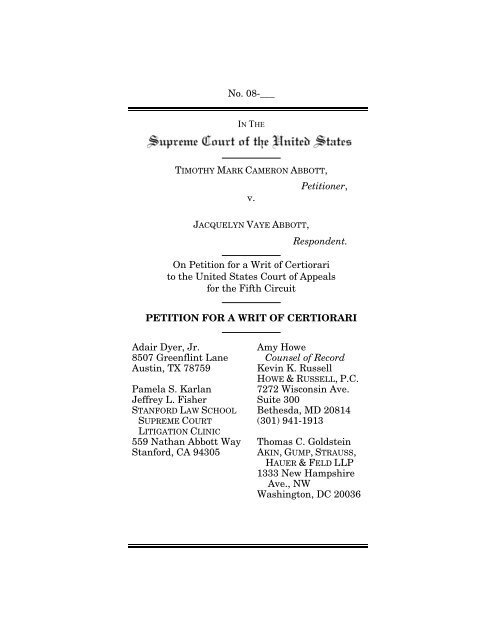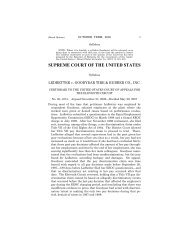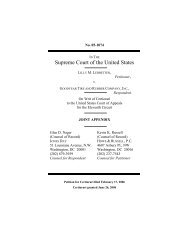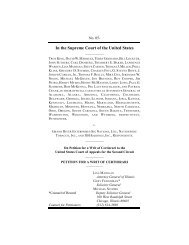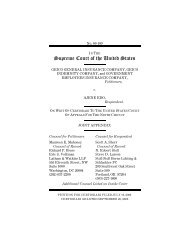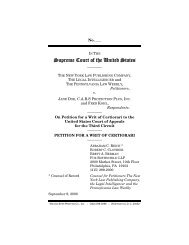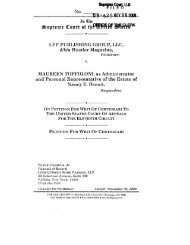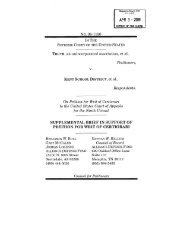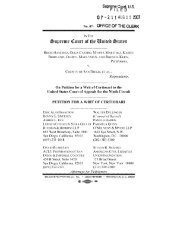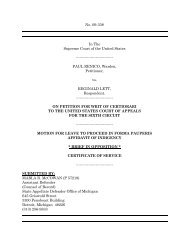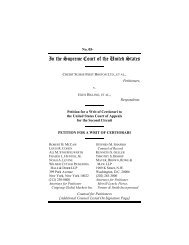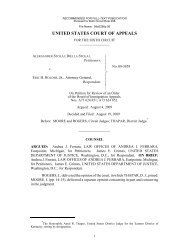Petition for a Writ of Certiorari - SCOTUSblog
Petition for a Writ of Certiorari - SCOTUSblog
Petition for a Writ of Certiorari - SCOTUSblog
Create successful ePaper yourself
Turn your PDF publications into a flip-book with our unique Google optimized e-Paper software.
No. 08-___<br />
IN THE<br />
TIMOTHY MARK CAMERON ABBOTT,<br />
v.<br />
<strong>Petition</strong>er,<br />
JACQUELYN VAYE ABBOTT,<br />
Respondent.<br />
On <strong>Petition</strong> <strong>for</strong> a <strong>Writ</strong> <strong>of</strong> <strong>Certiorari</strong><br />
to the United States Court <strong>of</strong> Appeals<br />
<strong>for</strong> the Fifth Circuit<br />
PETITION FOR A WRIT OF CERTIORARI<br />
Adair Dyer, Jr.<br />
8507 Greenflint Lane<br />
Austin, TX 78759<br />
Pamela S. Karlan<br />
Jeffrey L. Fisher<br />
STANFORD LAW SCHOOL<br />
SUPREME COURT<br />
LITIGATION CLINIC<br />
559 Nathan Abbott Way<br />
Stan<strong>for</strong>d, CA 94305<br />
Amy Howe<br />
Counsel <strong>of</strong> Record<br />
Kevin K. Russell<br />
HOWE & RUSSELL, P.C.<br />
7272 Wisconsin Ave.<br />
Suite 300<br />
Bethesda, MD 20814<br />
(301) 941-1913<br />
Thomas C. Goldstein<br />
AKIN, GUMP, STRAUSS,<br />
HAUER & FELD LLP<br />
1333 New Hampshire<br />
Ave., NW<br />
Washington, DC 20036
QUESTION PRESENTED<br />
The Hague Convention on International Child<br />
Abduction requires a country to return a child who<br />
has been “wrongfully removed” from his country <strong>of</strong><br />
habitual residence. Hague Convention art. 12. A<br />
“wrongful removal” is one that occurs “in breach <strong>of</strong><br />
rights <strong>of</strong> custody.” Id. art. 3. The question presented<br />
is:<br />
Whether a ne exeat clause (that is, a clause that<br />
prohibits one parent from removing a child from the<br />
country without the other parent’s consent) confers a<br />
“right <strong>of</strong> custody” within the meaning <strong>of</strong> the Hague<br />
Convention on International Child Abduction.
ii<br />
TABLE OF CONTENTS<br />
QUESTION PRESENTED ...........................................i<br />
PETITION FOR A WRIT OF CERTIORARI.............. 1<br />
OPINIONS BELOW .................................................... 1<br />
JURISDICTION........................................................... 1<br />
RELEVANT STATUTORY PROVISIONS ................. 1<br />
STATEMENT OF THE CASE..................................... 2<br />
REASONS FOR GRANTING THE WRIT .................. 6<br />
I. Federal Courts Are Intractably Divided Over<br />
Whether A Ne Exeat Clause Constitutes A<br />
“Right Of Custody” Under The Hague<br />
Convention. .......................................................... 7<br />
II. The Fifth Circuit’s Decision Conflicts With<br />
The Position Taken By The Vast Majority Of<br />
Sister Signatories That Have Addressed The<br />
Issue. .............................................................. 17<br />
III. The Fifth Circuit’s Decision Is Wrong On The<br />
Merits. ............................................................... 25<br />
A. The Convention’s Definition Of “Rights<br />
Of Custody” Includes A Ne Exeat Right...... 25<br />
B. The Convention’s Travaux Préparatoires<br />
Also Support The Conclusion That Ne<br />
Exeat Rights Constitute Rights Of<br />
Custody. ........................................................ 30<br />
CONCLUSION .......................................................... 33<br />
APPENDIX<br />
A. Court <strong>of</strong> Appeals Decision............................. 1a<br />
B. District Court Decision ............................... 15a
iii<br />
C. Hague Convention on the Civil Aspects <strong>of</strong><br />
International Child Abduction................... 27a<br />
D. International Child Abduction<br />
Remedies Act .............................................. 46a<br />
E. Minors Law 16,618 art. 49 (Chile).............. 61a<br />
F. Selections from Explanatory Report by<br />
Elisa Perez-Vera......................................... 63a<br />
G. Chilean Court Ne Exeat Order................... 68a
iv<br />
TABLE OF AUTHORITIES<br />
United States Cases<br />
Air France v. Saks, 470 U.S. 392 (1985) ............. 18, 30<br />
Altamiranda Vale v. Avila, 538 F.3d 581 (7th<br />
Cir. 2008) ............................................................ 7, 13<br />
Burnham v. Superior Court <strong>of</strong> Calif., 495 U.S.<br />
604 (1990) ............................................................... 16<br />
Croll v. Croll, 229 F.3d 133 (2d Cir. 2000), cert.<br />
denied, 534 U.S. 949 (2001) ........................... passim<br />
Cruzan v. Director, Missouri Dep’t <strong>of</strong> Health, 497<br />
U.S. 261 (1990) ....................................................... 27<br />
D’Assignies v. Escalante, No. BD 051876 (Cal.<br />
Super. Ct. Dec. 9, 1991) ......................................... 13<br />
David S. v. Zamira S., 574 N.Y.S.2d 429 (N.Y.<br />
Fam. Ct. 1991)........................................................ 13<br />
Duran v. Beaumont, 534 F.3d 142 (2d Cir. 2008)..... 14<br />
Eastern Airlines, Inc. v. Floyd, 499 U.S. 530<br />
(1991) ................................................................ 25, 30<br />
El Al Israel Airlines, Ltd. v. Tseng, 525 U.S. 155<br />
(1999) .............................................................. passim<br />
Fawcett v. McRoberts, 326 F.3d 491 (4th Cir.),<br />
cert. denied, 540 U.S. 1068 (2003) ................... 11, 17<br />
Friedrich v. Friedrich, 78 F.3d 1060 (6th Cir.<br />
1996) ....................................................................... 13<br />
Furnes v. Reeves, 362 F.3d 702 (11th Cir.), cert.<br />
denied, 543 U.S. 978 (2004) ........................... passim<br />
Gonzalez v. Gutierrez, 311 F.3d 942 (9th Cir.<br />
2002). ...................................................................... 11
v<br />
Janakakis-Kostun v. Janakakis, 6 S.W.3d 843<br />
(Ky. Ct. App. 1999), cert. denied, 531 U.S. 811<br />
(2000) ................................................................ 13, 17<br />
Lieberman v. Tabachnik, No. 07-cv-02415-WYD,<br />
2008 WL 1744353 (D. Colo. Apr. 10, 2008) ....... 7, 13<br />
Lops v. Lops, 140 F.3d 927 (11th Cir. 1998) ............. 16<br />
Pasten v. Velasquez, 462 F. Supp. 2d 1206 (M.D.<br />
Ala. 2006)................................................................ 16<br />
Shealy v. Shealy, 295 F.3d 1117 (10th Cir.), cert.<br />
denied, 537 U.S. 1048 (2002) ................................. 12<br />
Zicherman v. Korean Air Lines Co., 516 U.S. 217<br />
(1996) ...................................................................... 30<br />
Foreign Cases<br />
AJ v. FJ, [2005] CSIH 36 (Scot.) ............................... 20<br />
Bundesverfassungsgericht [BVerfG] [Federal<br />
Constitutional Court] July 18, 1997, 2 BvR<br />
1126/97 (F.R.G.) ..................................................... 20<br />
C. v. C. [1989] 1 W.L.R. 654 (Eng. C.A.) ................... 18<br />
Director-General Department <strong>of</strong> Families, Youth<br />
and Community Care and Hobbs, 24<br />
September 1999, Family Court <strong>of</strong> Australia<br />
(Brisbane) ............................................................... 19<br />
D.S. v. V.W., [1996] 2 S.C.R. 108 (Can.) ............. 23, 24<br />
Evans v. Evans [1989] 1 F.L.R. 135 (Eng.) ............... 19<br />
Foxman v. Foxman (H.C. 1992) (Isr.)........................ 20<br />
Goertz v. Gordon, [1996] 2 S.C.R. 27 (Can.).............. 24<br />
In Re D (a child) [2007] 1 A.C. 619 (H.L. 2006)........ 18<br />
In the Marriage <strong>of</strong>: Jose Garcia Resina and<br />
Muriel Gislaine Henriette Resina, Appeal No.<br />
52, 1991 (Fam) (Austl.) .......................................... 19
vi<br />
M.S.H v. L.H., [2000] 3 I.R. 390 (Supreme Court<br />
<strong>of</strong> Ireland) ............................................................... 20<br />
Ministere Public c. MB, Cour d’appel [CA]<br />
[regional court <strong>of</strong> appeal] Aix-en-Provence,<br />
Mar. 23, 1989, reprinted in 79 Rev. crit. 529<br />
(1990) ...................................................................... 22<br />
Ministere Public v. Mme. Y., Tribunal de grande<br />
instance [T.G.I.] [ordinary court <strong>of</strong> original<br />
jurisdiction] Perigueux, Mar. 17, 1992, D.S.<br />
Jur. 1992 (Fr.) ........................................................ 22<br />
Oberlandesgericht Dresden [High Regional<br />
Court] Jan. 21, 2002, 10 UF 753/01 (F.R.G.) ........ 20<br />
Oberster Gerichtsh<strong>of</strong> [OGH] [Supreme Court]<br />
Feb. 05, 1992, 2 Ob 596/91 (Austria)..................... 20<br />
Re P (A Child) (Abduction: Acquiescence) [2004]<br />
EWCA (Civ) 971 (Eng.) .......................................... 21<br />
Secretary <strong>for</strong> Justice v. Abrahams, Family Court<br />
at Taupo, Sept. 3, 2001 (N.Z.)................................ 20<br />
Sonderup v. Tondelli, 2000 (1) SA 1171 (CC) (S.<br />
Afr.)......................................................................... 21<br />
State Central Authority v. Ayob, (1997) 137<br />
F.L.R. 283 (Austl.).................................................. 19<br />
Thomson v. Thomson, [1994] 3 S.C.R. 551 (Can.) .... 23<br />
Thorne v. Dryden-Hall [1997] 148 D.L.R. (4th)<br />
508 (Can.). .............................................................. 24<br />
Statutes<br />
28 U.S.C. § 1254(1) ...................................................... 1<br />
28 U.S.C. § 1404......................................................... 16<br />
42 U.S.C. § 11601................................................... 2, 24<br />
42 U.S.C. § 11603....................................................... 16
vii<br />
CODE Civil Section 225 (Chile) .................................. 4<br />
Minors Law 16,618 art. 49 (Chile) .............................. 4<br />
International Law<br />
Hague Convention on the Civil Aspects <strong>of</strong><br />
International Child Abduction, Oct. 25, 1980,<br />
T.I.A.S. No. 11670 ........................................ passim<br />
Other Authorities<br />
Anton, A. E., The Hague Convention on<br />
International Child Abduction, 30 INT’L &<br />
COMP. L.Q. 537 (1981)............................................ 32<br />
BEAUMONT, PAUL & PETER E. MCELEAVY, THE<br />
HAGUE CONVENTION ON INTERNATIONAL CHILD<br />
ABDUCTION (1999) ............................................ 29, 31<br />
Br. Amicus Curiae <strong>of</strong> the United States, Crosby<br />
v. Nat’l Foreign Trade Council, 530 U.S. 363<br />
(2000) (No. 99-274), 2000 WL 194805 ................... 15<br />
Dyer, Adair, Questionnaire and Report on<br />
International Child Abduction by One Parent,<br />
in ACTES ET DOCUMENTS DE LA QUATORZIÈME<br />
SESSION, TOME III (1980)........................................ 30<br />
HAGUE CONFERENCE ON PRIVATE INTERNATIONAL<br />
LAW, ACTES ET DOCUMENTS DE LA<br />
QUATORZIÈME SESSION, TOME III (1980)................ 31<br />
H.R. REP. NO. 100-525 (1988), reprinted in 1988<br />
U.S.C.C.A.N. 386.................................................... 24<br />
H.R. REP. NO. 100-525 (Executive<br />
Communication submitted by the U.S.<br />
Department <strong>of</strong> State to the House <strong>of</strong><br />
Representatives on March 6, 1987 ........................ 24
viii<br />
Perez-Vera, Elisa, Explanatory Report on the<br />
1980 Hague Child Abduction Convention<br />
(“Perez-Vera Report”), in ACTES ET<br />
DOCUMENTS DE LA QUATORZIÈME SESSION,<br />
TOME III (1980)..................................... 27, 28, 30, 31<br />
Permanent Bureau, Hague Commission, Overall<br />
Conclusions <strong>of</strong> the Special Commission <strong>of</strong><br />
October 1989 on the Operation <strong>of</strong> the Hague<br />
Convention, 29 I.L.M. 219<br />
(October<br />
26, 1989) ........................................................... 23, 28<br />
Silberman, Linda, Interpreting the Hague<br />
Abduction Convention: In Search <strong>of</strong> a Global<br />
Jurisprudence, 38 U.C. DAVIS L. REV. 1049<br />
(2005) ........................................................................ 7<br />
Silberman, Linda, The Hague Child Abduction<br />
Convention Turns Twenty: Gender Politics<br />
and Other Issues, 33 N.Y.U. J. INT’L L. & POL.<br />
221 (2000) ............................................................... 28<br />
U.S. DEP’T OF STATE, MULTILATERAL TREATIES IN<br />
FORCE FOR THE UNITED STATES AS OF JAN. 1,<br />
2007 (2007) ............................................................... 2
1<br />
PETITION FOR A WRIT OF CERTIORARI<br />
<strong>Petition</strong>er Timothy Mark Cameron Abbott<br />
respectfully petitions <strong>for</strong> a writ <strong>of</strong> certiorari to review<br />
the judgment <strong>of</strong> the United States Court <strong>of</strong> Appeals<br />
<strong>for</strong> the Fifth Circuit.<br />
OPINIONS BELOW<br />
The opinion <strong>of</strong> the United States Court <strong>of</strong><br />
Appeals <strong>for</strong> the Fifth Circuit (Pet. App. 1a) is<br />
published at 542 F.3d 1081. The district court’s<br />
opinion (Pet. App. 15a) is published at 495 F. Supp.<br />
2d 635.<br />
JURISDICTION<br />
The judgment <strong>of</strong> the court <strong>of</strong> appeals was entered<br />
on September 16, 2008. Pet. App. 1a. This Court has<br />
jurisdiction pursuant to 28 U.S.C. § 1254(1).<br />
RELEVANT STATUTORY PROVISIONS<br />
The Hague Convention on the Civil Aspects <strong>of</strong><br />
International Child Abduction (Pet. App. 27a), the<br />
International Child Abduction Remedies Act (Pet.<br />
App. 46a), and Minors Law 16,618 art. 49 (Chile)<br />
(Pet. App. 61a) are reproduced in the <strong>Petition</strong><br />
Appendix.
2<br />
STATEMENT OF THE CASE<br />
This case presents an important question <strong>of</strong><br />
international law over which the federal courts <strong>of</strong><br />
appeals are intractably divided: whether a “ne exeat<br />
clause” confers a “right <strong>of</strong> custody” <strong>for</strong> purposes <strong>of</strong> the<br />
Hague Convention on International Child Abduction.<br />
The conclusion reached by a majority <strong>of</strong> U.S. courts <strong>of</strong><br />
appeals directly conflicts with the conclusions <strong>of</strong> the<br />
vast majority <strong>of</strong> our sister signatories. Moreover, the<br />
question presented recurs frequently and in practice<br />
is <strong>of</strong>ten determinative <strong>of</strong> parental rights involving<br />
children who are taken from their home countries.<br />
1. The United States is a signatory <strong>of</strong> the Hague<br />
Convention on the Civil Aspects <strong>of</strong> International<br />
Child Abduction, Oct. 25, 1980, T.I.A.S. No. 11670<br />
(“Hague Convention” or “Convention”). The<br />
Convention exists “to secure the prompt return <strong>of</strong><br />
children wrongfully removed or retained in any<br />
Contracting State” and “to ensure that rights <strong>of</strong><br />
custody and <strong>of</strong> access under the law <strong>of</strong> one<br />
Contracting State are effectively respected in the<br />
other Contracting States.” Hague Convention art. 1.<br />
Congress implemented the Convention – which came<br />
into <strong>for</strong>ce in the United States on July 1, 1988, see<br />
U.S. DEP’T OF STATE, MULTILATERAL TREATIES IN<br />
FORCE FOR THE UNITED STATES AS OF JAN. 1, 2007, at<br />
98 (2007) – in the International Child Abduction<br />
Remedies Act (“ICARA”), 42 U.S.C. § 11601 et seq.<br />
Under the Convention, a parent has the right to<br />
have his or her child returned to the country <strong>of</strong> the<br />
child’s habitual residence if the child “has been<br />
wrongfully removed or retained.” Hague Convention<br />
art. 12. Article 3 provides that a removal is wrongful
3<br />
when it occurs “in breach <strong>of</strong> rights <strong>of</strong> custody<br />
attributed to a person . . . either jointly or alone,<br />
under the law <strong>of</strong> the State in which the child was<br />
habitually resident immediately be<strong>for</strong>e the removal<br />
or retention.” Article 5(a) <strong>of</strong> the Convention in turn<br />
provides that “rights <strong>of</strong> custody shall include rights<br />
relating to the care <strong>of</strong> the person <strong>of</strong> the child, and, in<br />
particular the right to determine the child’s place <strong>of</strong><br />
residence.”<br />
In contrast to parents holding rights <strong>of</strong> custody,<br />
parents who merely hold “rights <strong>of</strong> access” – which<br />
the Convention describes as “includ[ing] the right to<br />
take a child <strong>for</strong> a limited period <strong>of</strong> time to a place<br />
other than the child’s habitual residence,” see Hague<br />
Convention art. 5(b) – cannot compel their child’s<br />
return to the country <strong>of</strong> his habitual residence.<br />
Instead, parents can only seek assistance in<br />
exercising those rights in the new country. See id.<br />
art. 21.<br />
2. <strong>Petition</strong>er Timothy Abbott, a British citizen,<br />
married respondent Jacquelyn Vaye Abbott, a U.S.<br />
citizen, in England in 1992. Pet. App. 1a.<br />
<strong>Petition</strong>er’s work as an astronomer specializing in<br />
detector science and telescope management took the<br />
couple to Hawaii, where their son A.J.A. was born in<br />
1995. Pet. App. 1a. After a three-year stay in the<br />
Canary Islands, the Abbotts moved to Chile, where<br />
petitioner had accepted a new job. Pet. App. 1a.<br />
<strong>Petition</strong>er and respondent separated in March<br />
2003. Pet. App. 1a. Litigation in the Chilean family<br />
courts produced various court orders, four <strong>of</strong> which<br />
are relevant here. The first, entered in January<br />
2004, granted petitioner “direct and regular”<br />
visitation rights. Pet. App. 17a. The second, entered
4<br />
in November 2004, left daily care and control <strong>of</strong><br />
A.J.A. with respondent. 1 Pet. App. 17a. The third,<br />
entered in February 2005, expanded petitioner’s<br />
visitation rights to include a full month <strong>of</strong> summer<br />
vacation. Pet. App. 2a. The fourth, entered on<br />
January 13, 2004, prohibited both parents from<br />
removing A.J.A. from Chile without written<br />
authorization from the court. Pet. App. 2a. In<br />
addition to the Chilean family court ne exeat order,<br />
petitioner also held a ne exeat right under a Chilean<br />
statute that requires authorization from a parent<br />
having visitation rights be<strong>for</strong>e the other parent may<br />
take a child out <strong>of</strong> Chile. Minor’s Law 16,618 art. 49<br />
(Chile) (Pet. App. 61a).<br />
In July 2005, petitioner sought an order from<br />
Chilean courts that would have expanded his rights<br />
with respect to his son. See Pet. App. 2a. Shortly<br />
thereafter, in August 2005, respondent violated the<br />
ne exeat order and Chilean law, taking petitioner’s<br />
son out <strong>of</strong> Chile without petitioner’s knowledge or the<br />
court’s consent. Pet. App. 17a. <strong>Petition</strong>er hired a<br />
private investigator and, four months after the<br />
removal, located his son in Texas. Pet. App. 2a.<br />
3. <strong>Petition</strong>er filed this suit in federal district<br />
court in Texas, seeking to have his son returned to<br />
Chile pursuant to the Hague Convention and ICARA.<br />
Pet. App. 18a. The district court denied petitioner’s<br />
1<br />
Such an order was consistent with Chilean law, which – absent<br />
a showing by the father that she is unfit – vests responsibility<br />
<strong>for</strong> the personal care <strong>of</strong> a child with the mother, without any<br />
implication that the father is an inadequate parent. See CODE<br />
Civil Section 225 (Chile).
5<br />
request. Pet. App. 15a. Although respondent<br />
conceded that her removal violated Chilean law (and<br />
in particular the ne exeat order), Pet. App. 6a, 19a-<br />
20a, and the court acknowledged that respondent’s<br />
removal <strong>of</strong> A.J.A. without petitioner’s consent or<br />
knowledge “violated and frustrated the Chilean<br />
court’s order,” Pet. App. 24a, the court concluded that<br />
the removal was not “wrongful” within the meaning<br />
<strong>of</strong> the Hague Convention because petitioner’s ne<br />
exeat right did not constitute a right <strong>of</strong> custody under<br />
the Convention. Pet. App. 26a.<br />
4. On appeal, the Fifth Circuit affirmed. As an<br />
initial matter, the panel recognized that the courts <strong>of</strong><br />
appeals are divided on the question whether a ne<br />
exeat right constitutes a “right <strong>of</strong> custody” <strong>for</strong><br />
purposes <strong>of</strong> the Hague Convention. Pet. App. 6a-7a.<br />
The Fifth Circuit explained that three courts,<br />
including the Second Circuit in Croll v. Croll, 229<br />
F.3d 133 (2d Cir. 2000), cert. denied, 534 U.S. 949<br />
(2001), had answered the question in the negative,<br />
while in Furnes v. Reeves, 362 F.3d 702 (11th Cir.),<br />
cert. denied, 543 U.S. 978 (2004), the Eleventh<br />
Circuit had “explicitly rejected Croll” by holding that<br />
“a ne exeat right alone is sufficient to constitute a<br />
custody right.” Pet. App. 6a-7a (footnote omitted).<br />
The Fifth Circuit also noted that “<strong>for</strong>eign courts<br />
disagree regarding whether ne exeat rights are<br />
‘rights <strong>of</strong> custody’ within the meaning <strong>of</strong> the Hague<br />
Convention.” Pet. App. 11a.<br />
Adopting the Second Circuit’s holding in Croll,<br />
the Fifth Circuit held that it lacked authority to order<br />
A.J.A.’s return to Chile because petitioner had only<br />
“rights <strong>of</strong> access,” rather than “rights <strong>of</strong> custody.” See<br />
Pet. App. 14a. The panel reasoned that although
6<br />
“[t]he ne exeat order . . . gave [petitioner] a veto right<br />
over his son’s departure from Chile, . . . it did not give<br />
him any rights to determine where in Chile his son<br />
would live.” Pet. App. 13a. Moreover, the panel<br />
emphasized, “the Chilean family court, in its second<br />
order, expressly denied the father’s request <strong>for</strong><br />
custody rights and awarded all custody rights to the<br />
mother.” Id. Finally, the panel deemed “persuasive<br />
Croll’s reasoning that the Hague Convention clearly<br />
distinguishes between ‘rights <strong>of</strong> custody’ and ‘rights<br />
<strong>of</strong> access’ and that ordering the return <strong>of</strong> a child in<br />
the absence <strong>of</strong> ‘rights <strong>of</strong> custody’ in an ef<strong>for</strong>t to serve<br />
the overarching purposes <strong>of</strong> the Hague Convention<br />
would be an impermissible judicial amendment <strong>of</strong> the<br />
Convention.” Id.<br />
REASONS FOR GRANTING THE WRIT<br />
The Hague Convention is the primary source <strong>of</strong><br />
international law governing the return <strong>of</strong> children<br />
who have been abducted by a parent to another<br />
country. However, federal courts are deeply divided<br />
over whether a ne exeat right confers a right <strong>of</strong><br />
custody under the Hague Convention. This conflict is<br />
untenable because it undermines bedrock<br />
constitutional principles and creates perverse<br />
incentives <strong>for</strong> would-be child abductors. This case<br />
presents an ideal opportunity <strong>for</strong> this Court to<br />
resolve the question presented, which was squarely<br />
raised below and was the sole basis <strong>for</strong> the Fifth<br />
Circuit’s decision in this case. The Fifth Circuit’s<br />
decision also breaks with the long-established<br />
position taken by the vast majority <strong>of</strong> our sister<br />
signatories that have addressed this issue. Finally,<br />
certiorari is also warranted because the Fifth
7<br />
Circuit’s decision is wrong on the merits, frustrating<br />
the goals and operation <strong>of</strong> the Hague Convention.<br />
I. Federal Courts Are Intractably Divided<br />
Over Whether A Ne Exeat Clause<br />
Constitutes A “Right Of Custody” Under<br />
The Hague Convention.<br />
Four appellate courts – the Second, Fourth,<br />
Ninth, and now the Fifth – have held that a ne exeat<br />
order does not create a “right <strong>of</strong> custody” under the<br />
Hague Convention. The Eleventh Circuit, and at<br />
least three state courts, have reached the opposite<br />
conclusion. Numerous federal courts and<br />
commentators have recognized this direct split in<br />
authority. See, e.g., Altamiranda Vale v. Avila, 538<br />
F.3d 581, 586 (7th Cir. 2008) (“[In contrast to<br />
Furnes,] several cases . . . hold that the doctrine <strong>of</strong> ne<br />
exeat does not create a right <strong>of</strong> custody.”); Lieberman<br />
v. Tabachnik, No. 07-cv-02415-WYD, 2008 WL<br />
1744353, at *9-*10 (D. Colo. Apr. 10, 2008) (“[T]he<br />
Eleventh Circuit reached the opposite conclusion <strong>of</strong><br />
the Croll majority.”); Linda Silberman, Interpreting<br />
the Hague Abduction Convention: In Search <strong>of</strong> a<br />
Global Jurisprudence, 38 U.C. DAVIS L. REV. 1049,<br />
1070-72 (2005).<br />
1. The first federal appellate court to hold that a<br />
ne exeat order does not constitute a right <strong>of</strong> custody<br />
under the Hague Convention was the Second Circuit<br />
in Croll v. Croll, 229 F.3d 133 (2d Cir. 2000), cert.<br />
denied, 534 U.S. 949 (2001). In that case, a divided<br />
panel <strong>of</strong> the Second Circuit held that “a ne exeat<br />
clause does not transmute access rights into rights <strong>of</strong><br />
custody under the Convention.” Id. at 143. First,<br />
relying on several U.S. dictionaries, the majority
8<br />
concluded that the “ordinary meaning” <strong>of</strong> custody<br />
“entails the primary duty and ability to choose and<br />
give sustenance, shelter, clothing, moral and<br />
spiritual guidance, medical attention, etc.” Id. at<br />
136, 138 (emphasis deleted). Positing that “[n]othing<br />
in the Hague Convention suggests that the drafters<br />
intended anything other than this ordinary<br />
understanding <strong>of</strong> custody,” the majority thus<br />
reasoned that “rights <strong>of</strong> custody” refers to a “bundle<br />
<strong>of</strong> rights” relating to control over a child’s care and<br />
upbringing. Id. at 139 (emphasis in original). The<br />
court rejected Mr. Croll’s contention that the ne exeat<br />
clause constituted a “right to determine the child’s<br />
place <strong>of</strong> residence” and was thus a “‘right <strong>of</strong> custody’ .<br />
. . protected by the Convention’s return remedy.” Id.<br />
Instead, the majority explained, the right to<br />
determine a child’s residence is merely “indicative” <strong>of</strong><br />
who actually has custodial rights, while the “power to<br />
pick her home country or territory. . . . protects rights<br />
<strong>of</strong> custody and access alike, and is no clue as to who<br />
has custody.” Id. And in any event, the court<br />
reasoned, the ne exeat clause only limited Mrs.<br />
Croll’s right to expatriate her child; it did not vest<br />
Mr. Croll with an affirmative right to determine<br />
where the child would live. See id. This “single veto<br />
power” alone, the court found, “falls short <strong>of</strong><br />
conferring a joint right to determine the child’s<br />
residence.” Id.<br />
Second, the majority found that the removal was<br />
not “wrongful” because it was not “in breach <strong>of</strong><br />
custodial rights <strong>of</strong> the petitioning parent that ‘were<br />
actually exercised . . . or would have been so exercised<br />
but <strong>for</strong> the removal.’” Croll, 229 F.3d at 140 (quoting<br />
Hague Convention art. 3) (emphasis in original). A
9<br />
ne exeat clause, the majority opined, cannot meet<br />
this requirement because “the right itself concerns<br />
nothing but removal itself,” and would never be<br />
exercised absent removal. Id.<br />
Third, the majority contended that interpreting<br />
the Convention to require a child’s return based<br />
solely on a violation <strong>of</strong> a ne exeat right would render<br />
the Convention unworkable. Croll, 229 F.3d at 140.<br />
A “foundational assumption” <strong>of</strong> the Convention, the<br />
majority maintained, is that the remedy <strong>of</strong> return<br />
will place the child back into the care <strong>of</strong> a custodial<br />
parent, not a parent “whose sole right—to visit or<br />
veto—imposes no duty to give care.” Id. Because the<br />
return order does not also compel the parent who<br />
expatriates the child to return, “the effect <strong>of</strong><br />
compelling [the child’s] return . . . would be to alter<br />
custody rights rather than to en<strong>for</strong>ce them.” Id. at<br />
141.<br />
Fourth and finally, the majority pointed to the<br />
Convention’s ratification history, finding support in<br />
the drafters’ understanding that different remedies<br />
applied to rights <strong>of</strong> custody and rights <strong>of</strong> access<br />
Croll, 229 F.3d at 141-42.<br />
By contrast, the majority declined to attribute<br />
any weight to decisions by <strong>for</strong>eign courts holding that<br />
ne exeat rights do constitute “rights <strong>of</strong> custody,”<br />
dismissing the <strong>for</strong>eign decisions as “few, scattered,<br />
[and] conflicting” and thus reflecting no consensus<br />
view to which deference might be owed. Croll, 229<br />
F.3d at 143.<br />
Judge Sotomayor dissented. In her view, “the<br />
Convention’s text, object and purpose, as well as the<br />
relevant case law” all clearly indicate that a ne exeat
10<br />
clause confers a right <strong>of</strong> custody. Croll, 229 F.3d at<br />
145. Looking first at “the Convention and its <strong>of</strong>ficial<br />
history,” Judge Sotomayor concluded that the<br />
Convention’s drafters intended “a notably more<br />
expansive conception <strong>of</strong> custody rights” than the<br />
“parochial” definition gleaned by the majority from<br />
American dictionaries. Id. at 145-46. The<br />
Convention’s primary goals were to “prevent[]<br />
parents from unilaterally circumventing the home<br />
country’s custody law” in search <strong>of</strong> a friendlier <strong>for</strong>um.<br />
Id. at 149. Ordering the return <strong>of</strong> a child who has<br />
been abducted in violation <strong>of</strong> a ne exeat order<br />
“directly and fully advances” these goals, she<br />
reasoned, because a parent who violates a ne exeat<br />
order in her home country “nullifies that country’s<br />
custody law as effectively as does the parent who<br />
kidnaps a child in violation <strong>of</strong> the rights <strong>of</strong> the parent<br />
with physical custody <strong>of</strong> that child.” Id. at 147, 149.<br />
Countering the majority’s description <strong>of</strong> a ne<br />
exeat right as a mere veto power unrelated to<br />
custody, Judge Sotomayor emphasized that a ne<br />
exeat clause in fact gives a parent significant<br />
decision-making authority. Croll, 229 F.3d at 146.<br />
The Convention is not concerned with a child’s<br />
location within her country <strong>of</strong> habitual residence;<br />
rather, it is designed specifically to protect parents’<br />
rights to determine the country in which their<br />
children live. Id. at 147. In light <strong>of</strong> this context,<br />
Judge Sotomayor reasoned, the right to choose the<br />
country in which a child lives must constitute a “right<br />
to determine the child’s place <strong>of</strong> residence” under<br />
Article 5 and there<strong>for</strong>e a “right <strong>of</strong> custody” under the<br />
Convention. Id. at 148.
11<br />
Moreover, Judge Sotomayor explained, ne exeat<br />
rights differ fundamentally from rights <strong>of</strong> access. Ne<br />
exeat rights, she emphasized, “circumscribe the<br />
choices <strong>of</strong> the parent with physical custody” in a way<br />
that access rights do not, because although a parent<br />
with access rights may still be able to exercise those<br />
rights even after his or her child has been removed,<br />
the removal <strong>of</strong> a child without mutual consent<br />
necessarily violates the other parent’s ne exeat<br />
rights. Croll, 229 F.3d at 148. And – contrary to the<br />
majority’s characterization <strong>of</strong> the <strong>for</strong>eign case law –<br />
Judge Sotomayor noted that “most <strong>for</strong>eign courts to<br />
consider the issue” have held that a ne exeat order<br />
constitutes a right <strong>of</strong> custody. Id. at 150.<br />
The majority’s reasoning in Croll has largely<br />
been adopted by the Fifth Circuit in this case, as well<br />
as the Fourth and Ninth Circuits, both <strong>of</strong> which have<br />
held that a ne exeat clause does not constitute a right<br />
<strong>of</strong> custody. See Fawcett v. McRoberts, 326 F.3d 491<br />
(4th Cir.), cert. denied, 540 U.S. 1068 (2003);<br />
Gonzalez v. Gutierrez, 311 F.3d 942 (9th Cir. 2002).<br />
2. As the Fifth Circuit acknowledged, Pet. App.<br />
3a-4a, the holding <strong>of</strong> these courts <strong>of</strong> appeals conflicts<br />
with the Eleventh Circuit’s decision in Furnes v.<br />
Reeves, 362 F.3d 702 (11th Cir.), cert. denied, 543<br />
U.S. 978 (2004), holding that a ne exeat right,<br />
standing alone, “grant[s] . . . a ‘right <strong>of</strong> custody’ under<br />
the Convention” because it “amounts to the right to<br />
determine the child’s place <strong>of</strong> residence.” 362 F.3d at<br />
714 (quotation marks omitted).<br />
The court acknowledged the contrary holdings <strong>of</strong><br />
the Second, Fourth, and Ninth Circuits, but found<br />
their reasoning to be “flawed.” Furnes, 362 F.3d at<br />
719. Specifically, the court rejected the Croll
12<br />
majority’s characterization <strong>of</strong> the ne exeat right as a<br />
mere limitation on the right <strong>of</strong> the sole custodial<br />
parent. Id. at 720. Instead, the Eleventh Circuit<br />
reasoned, when a ne exeat order is in place parents<br />
“share a divided right to determine [the child’s] place<br />
<strong>of</strong> residence, and . . . each <strong>of</strong> their rights serves as a<br />
limitation on the other’s. Stated simply, they possess<br />
a joint right to determine [the child’s] place <strong>of</strong><br />
residence.” Id. That interpretation, the court also<br />
explained, was – unlike the Second Circuit’s – most<br />
consistent with the purpose <strong>of</strong> the Convention, the<br />
drafter’s intent, and the reasoning and conclusions <strong>of</strong><br />
the majority <strong>of</strong> the courts <strong>of</strong> sister signatories that<br />
have addressed the issue. Id. at 717, 720-22.<br />
Three other courts <strong>of</strong> appeals, while not directly<br />
addressing the question presented, have suggested<br />
that they too would construe a ne exeat clause as<br />
constituting a “right <strong>of</strong> custody” <strong>for</strong> purposes <strong>of</strong> the<br />
Convention. In Shealy v. Shealy, 295 F.3d 1117, 1122<br />
(10th Cir.), cert. denied, 537 U.S. 1048 (2002), the<br />
Tenth Circuit held that the removal <strong>of</strong> the child from<br />
Germany to the United States without the father’s<br />
permission was not wrongful <strong>for</strong> purposes <strong>of</strong> the<br />
Convention because the particular ne exeat clause at<br />
issue allowed the child’s removal without the father’s<br />
permission in cases <strong>of</strong> military necessity. In<br />
affirming the district court’s finding that a military<br />
necessity indeed existed, the Tenth Circuit appeared<br />
to assume that violation <strong>of</strong> a ne exeat order would<br />
constitute a breach <strong>of</strong> “rights <strong>of</strong> custody” under the<br />
Convention, as it explained that “[i]f a military<br />
necessity did exist, then there was no violation <strong>of</strong> the<br />
ne exeat order or, accordingly, <strong>of</strong> Mr. Shealy’s custody<br />
rights under German law.” 295 F.3d at 1122 & n.3;
13<br />
see also Lieberman v. Tabachnik, No. 07-cv-02415-<br />
WYD, 2008 WL 1744353, at *11 (D. Colo. Apr. 10,<br />
2008) (relying on Furnes to hold that the “only logical<br />
construction <strong>of</strong> the term ‘right to determine place <strong>of</strong><br />
residence’ in the Convention must encompass<br />
decisions regarding whether a child may live outside<br />
<strong>of</strong> their country <strong>of</strong> habitual residence”). Similarly, in<br />
Altamiranda Vale v. Avila, 538 F.3d 581 (7th Cir.<br />
2008) (Posner, J.), the Seventh Circuit suggested that<br />
a parent with a ne exeat right “clearly” possesses “the<br />
right to determine . . . the child’s place <strong>of</strong> residence,”<br />
id. at 586 (quotation omitted); see also Friedrich v.<br />
Friedrich, 78 F.3d 1060, 1065 n.4 (6th Cir. 1996)<br />
(describing decision in David S. v. Zamira S., 574<br />
N.Y.S.2d 429 (N.Y. Fam. Ct. 1991), treating ne exeat<br />
rights as “custodial,” as “ably resolv[ing] a<br />
“particularly difficult situation”).<br />
The Fifth Circuit’s holding also cannot be<br />
reconciled with the decisions <strong>of</strong> three state courts, all<br />
<strong>of</strong> which have held that a removal in violation <strong>of</strong> a ne<br />
exeat clause is wrongful <strong>for</strong> purposes <strong>of</strong> the<br />
Convention. See Janakakis-Kostun v. Janakakis, 6<br />
S.W.3d 843 (Ky. Ct. App. 1999), cert. denied, 531 U.S.<br />
811 (2000); David S. v. Zamira S., 574 N.Y.S.2d 429,<br />
432 (N.Y. Fam. Ct. 1991) (deeming a child’s removal<br />
“wrongful” under the Hague Convention when the<br />
other parent had visitation rights and a ne exeat<br />
order was in place); D’Assignies v. Escalante, No. BD<br />
051876 (Cal. Super. Ct. Dec. 9, 1991), available at<br />
http://www.hcch.net/incadat/fullcase/0198.htm<br />
(same).<br />
3. This division <strong>of</strong> authority is considered,<br />
mature, and entrenched. In reaching its decision in<br />
this case, the Fifth Circuit expressly acknowledged
14<br />
that the Eleventh Circuit’s holding in Furnes<br />
conflicted with those <strong>of</strong> the Second, Fourth, and<br />
Ninth Circuits and opted to follow the latter circuits<br />
in holding that a ne exeat right is not a “right <strong>of</strong><br />
custody” <strong>for</strong> purposes <strong>of</strong> the Convention. See Pet.<br />
App. 3a-4a. Similarly, in Furnes the Eleventh Circuit<br />
acknowledged the holdings <strong>of</strong> the Second, Fourth,<br />
and Ninth Circuits, but it nonetheless rejected not<br />
only those courts’ holdings but also every aspect <strong>of</strong><br />
their reasoning. See 362 F.3d at 719-22. Moreover,<br />
there is no reason to believe that any <strong>of</strong> the circuits<br />
will reconsider their positions: the Eleventh Circuit<br />
denied rehearing en banc in Furnes, 107 Fed. Appx.<br />
186 (11th Cir. 2004), while the Second Circuit has<br />
recently reaffirmed its holding in Croll, see Duran v.<br />
Beaumont, 534 F.3d 142 (2d Cir. 2008).<br />
Nor would the question presented benefit from<br />
further percolation. Not only have the federal courts<br />
<strong>of</strong> appeals thoroughly ventilated the arguments on<br />
both sides <strong>of</strong> the issue, but numerous <strong>for</strong>eign courts<br />
have also weighed in on the status <strong>of</strong> ne exeat clauses<br />
under the treaty, see infra Part II. Moreover, the<br />
courts that have confronted the question presented in<br />
recent years have simply noted the split in authority<br />
and chosen sides. It is there<strong>for</strong>e unlikely that this<br />
conflict will be resolved without this Court’s<br />
intervention.<br />
4. This Court’s intervention is also necessary<br />
because the current lack <strong>of</strong> national uni<strong>for</strong>mity both<br />
undermines fundamental constitutional principles<br />
and obstructs the Convention’s proper operation.<br />
As this Court has consistently recognized,<br />
uni<strong>for</strong>mity in federal law is particularly important in<br />
the field <strong>of</strong> international relations, where courts must
15<br />
remember that “the nation-state, not subdivisions<br />
within one nation, is . . . the perspective <strong>of</strong> our treaty<br />
partners.” El Al Israel Airlines, Ltd. v. Tseng, 525<br />
U.S. 155, 175 (1999). The Framers’ emphasis on the<br />
need <strong>for</strong> national uni<strong>for</strong>mity reflected their<br />
experience during the early years <strong>of</strong> this nation, as<br />
“the national government’s ef<strong>for</strong>ts to engage in<br />
political and commercial relations with other<br />
countries [were] undermined by the States” under the<br />
Articles <strong>of</strong> Confederation. Br. Amicus Curiae <strong>of</strong> the<br />
United States 12, Crosby v. Nat’l Foreign Trade<br />
Council, 530 U.S. 363 (2000) (No. 99-274), 2000 WL<br />
194805. In response, the Framers “propose[d] a<br />
Constitution that provided <strong>for</strong> a single national voice<br />
over <strong>for</strong>eign political and commercial affairs.” Id. at<br />
13. And although the concerns voiced by the Framers<br />
and echoed by this Court involve the prospect that a<br />
single state’s actions may affect the entire union,<br />
such concerns are even more pressing when federal<br />
law, which was intended to ensure national<br />
uni<strong>for</strong>mity, is itself inconsistent.<br />
Moreover, the lack <strong>of</strong> a uni<strong>for</strong>m interpretation <strong>of</strong><br />
the Convention “could produce several anomalies” in<br />
federal law. El Al, 525 U.S. at 171. The first, and<br />
most basic, anomaly is that the same case could be<br />
decided differently based solely on the judicial circuit<br />
to which a parent has opted to remove her child.<br />
Thus, <strong>for</strong> example, if respondent had chosen to settle<br />
in Florida rather than Texas, petitioner’s child would<br />
have been returned to Chile. Such momentous<br />
decisions relating to the course <strong>of</strong> a child’s life should<br />
not be determined by an accident <strong>of</strong> geography.<br />
Venue rules may further exacerbate the<br />
situation. ICARA provides that venue is proper “in
16<br />
any court which has jurisdiction <strong>of</strong> such action and<br />
which is authorized to exercise its jurisdiction in the<br />
place where the child is located at the time the<br />
petition is filed.” 42 U.S.C. § 11603(b) (emphasis<br />
added). Thus, <strong>for</strong> example, a parent seeking the<br />
return <strong>of</strong> a child currently residing in the Fifth<br />
Circuit could avoid that circuit’s precedent by serving<br />
the other parent with process when he or she takes<br />
the child to another circuit – <strong>for</strong> example, to Disney<br />
World in the Eleventh – that applies a contrary<br />
interpretation <strong>of</strong> the Convention. See Burnham v.<br />
Superior Court <strong>of</strong> Calif., 495 U.S. 604 (1990); cf.<br />
Pasten v. Velasquez, 462 F. Supp. 2d 1206 (M.D. Ala.<br />
2006) (mother moved with child from Texas to<br />
Alabama, in violation <strong>of</strong> Chilean court order limiting<br />
mother to three-year stay in Texas to attend school;<br />
applying Furnes, court reasoned that move was<br />
“wrongful” <strong>for</strong> purposes <strong>of</strong> Convention because<br />
violation <strong>of</strong> court order “amounts to a violation <strong>of</strong> [the<br />
father’s] ne exeat right”). In this scenario, ICARA’s<br />
venue provision would preclude any transfer <strong>of</strong> the<br />
case back to the Fifth Circuit. See 28 U.S.C.<br />
§ 1404(a) (“a district court may transfer any civil<br />
action to any other district or division where it might<br />
have been brought”) (emphasis added); cf. Lops v.<br />
Lops, 140 F.3d 927, 937 (11th Cir. 1998) (children<br />
living in South Carolina “located” in Georgia <strong>for</strong><br />
purposes <strong>of</strong> ICARA when they were picked up while<br />
visiting their grandmother in Georgia).<br />
5. This case is also an ideal vehicle <strong>for</strong> this<br />
Court to resolve the question presented. The facts<br />
are undisputed: respondent concedes that she<br />
violated the ne exeat order and the Chilean statute<br />
prohibiting A.J.A.’s removal, and she does not
17<br />
contend that any <strong>of</strong> the Convention’s exceptions to<br />
the remedy <strong>of</strong> return in cases <strong>of</strong> wrongful removal<br />
apply here. The question presented is thus squarely<br />
raised and outcome determinative in this case, in<br />
which the decisions <strong>of</strong> the courts below rested solely<br />
on their conclusion that petitioner lacked “rights <strong>of</strong><br />
custody.”<br />
Nor is there any danger that this case might<br />
become moot be<strong>for</strong>e this Court can resolve it. Unlike<br />
Fawcett v. McRoberts, 326 F.3d 491 (4th Cir.), cert.<br />
denied, 540 U.S. 1068 (2003), and Janakakis-Kostun<br />
v. Janakakis, 6 S.W.3d 843 (Ky. Ct. App. 1999), cert.<br />
denied, 531 U.S. 811 (2000), in which the child was<br />
returned pursuant to a lower court order prior to<br />
appellate proceedings, petitioner’s son remains in the<br />
United States. Moreover, because the Convention<br />
applies until the child is sixteen, Hague Convention<br />
art. 4, and A.J.A. does not reach that age until 2011,<br />
Pet. App. 1a, this case <strong>of</strong>fers the opportunity <strong>for</strong> this<br />
Court to consider the question presented<br />
unencumbered by any concern that its ultimate<br />
decision will have no effect on the parties.<br />
II. The Fifth Circuit’s Decision Conflicts With<br />
The Position Taken By The Vast Majority<br />
Of Sister Signatories That Have Addressed<br />
The Issue.<br />
Although certiorari is warranted based solely on<br />
the conflict among the federal courts <strong>of</strong> appeals,<br />
certiorari also should be granted because the Fifth<br />
Circuit’s holding conflicts with the interpretation<br />
overwhelmingly adopted by the <strong>for</strong>eign courts that<br />
have addressed this issue. In construing the terms <strong>of</strong><br />
a treaty, “the opinions <strong>of</strong> our sister signatories [are]
18<br />
entitled to considerable weight.” Air France v. Saks,<br />
470 U.S. 392, 404 (1985) (quotation omitted). But the<br />
Fifth Circuit effectively ignored the virtual consensus<br />
in favor <strong>of</strong> treating ne exeat rights as rights <strong>of</strong><br />
custody.<br />
1. The question presented has arisen in eleven<br />
other countries that are signatories to the<br />
Convention. In nine <strong>of</strong> those countries, courts have<br />
held that ne exeat orders create rights <strong>of</strong> custody. In<br />
so ruling, these courts have relied on the text <strong>of</strong> the<br />
Convention itself and the practical effect <strong>of</strong> a ne exeat<br />
clause, as well as the purpose <strong>of</strong> the Convention.<br />
One <strong>of</strong> the first cases to consider the question<br />
presented was the English case <strong>of</strong> C. v. C., in which a<br />
mother violated a consent order with a ne exeat<br />
clause by taking her child abroad. [1989] 1 W.L.R.<br />
654 (Eng. C.A.). The court held that the ne exeat<br />
order conferred rights <strong>of</strong> custody because the father<br />
had “the right to determine that the child should<br />
reside in [the country <strong>of</strong> habitual residence]”; these<br />
“limited rights and joint rights,” the court explained,<br />
are “recognized” under Article 3 and are “within [the]<br />
scope” <strong>of</strong> the Convention. Id. at 658. 2 In his<br />
concurring opinion, Lord Donaldson acknowledged<br />
that “‘[c]ustody’, as a matter <strong>of</strong> non-technical English,<br />
means ‘safe keeping, protection; charge, care,<br />
guardianship,’” but he emphasized that “‘rights <strong>of</strong><br />
2<br />
See also In Re D (a child) [2007] 1 A.C. 619, 37 (H.L. 2006)<br />
(House <strong>of</strong> Lords finding removal not wrongful in absence <strong>of</strong><br />
explicit ne exeat right but also indicating that “a right <strong>of</strong> veto<br />
[requiring consent be<strong>for</strong>e child may be removed from country]<br />
does amount to ‘rights <strong>of</strong> custody’” <strong>for</strong> purposes <strong>of</strong> Convention).
19<br />
custody’ as defined in the convention includes a much<br />
more precise meaning . . . . This is ‘the right to<br />
determine the child’s place <strong>of</strong> residence.’” Id. at 663<br />
(Lord Donaldson M.R., concurring). Although this<br />
right may take many <strong>for</strong>ms, he continued, “[i]f<br />
anyone, be it an individual or the court or other<br />
institution or a body, has a right to object [to<br />
removal], and either is not consulted or refuses<br />
consent, the removal will be wrongful within the<br />
meaning <strong>of</strong> the convention.” Id. Such a conclusion<br />
was also, the court found, consistent with “the whole<br />
purpose <strong>of</strong> this Convention” – that is, “to ensure that<br />
parties do not gain adventitious advantage by either<br />
removing a child wrongfully from the country <strong>of</strong> its<br />
usual residence, or having taken the child with the<br />
agreement <strong>of</strong> any other party who has custodial<br />
rights to another jurisdiction, then wrongfully to<br />
retain that child.” 1 W.L.R. 654, 661 (citing Evans v.<br />
Evans [1989] 1 F.L.R. 135, 142 (Eng.)); see also In the<br />
Marriage <strong>of</strong>: Jose Garcia Resina and Muriel Gislaine<br />
Henriette Resina, Appeal No. 52, 1991 (Fam) (Austl.),<br />
2, available at http://www.austlii.edu.au/au/<br />
cases/cth/FamCA/1991/33.html (holding that “[t]he<br />
reasoning adopted by the Court <strong>of</strong> Appeal in C. v. C.<br />
should be applied in Australia both <strong>for</strong> reasons <strong>of</strong><br />
uni<strong>for</strong>mity <strong>of</strong> interpretation and having regard to the<br />
spirit and intendment <strong>of</strong> the Convention”). 3<br />
3<br />
See also Director-General Department <strong>of</strong> Families, Youth and<br />
Community Care and Hobbs, 24 Sept. 1999, Family Court <strong>of</strong><br />
Australia (Brisbane) (rights <strong>of</strong> custody exist when parental<br />
agreement contains a ne exeat clause), available at<br />
http://www.hcch.net/incadat/fullcase/0294.htm; State Central
20<br />
Courts in six other countries have reached the<br />
same conclusion. See, e.g., Oberster Gerichtsh<strong>of</strong><br />
[OGH] [Supreme Court] Feb. 05, 1992, 2 Ob 596/91<br />
(Austria), available at http://www.incadat.com/index.<br />
cfm?fuseaction=convtext.showFull&code=375&lng=1<br />
(INCADAT summary); Bundesverfassungsgericht<br />
[BVerfG] [Federal Constitutional Court] July 18,<br />
1997, 2 BvR 1126/97 (F.R.G.), available at<br />
http://www.incadat.com/index.cfm?fuseaction=convte<br />
xt.showFull&lng=1&code=338<br />
(INCADAT<br />
summary); 4 CA 5271/92 Foxman v. Foxman (H.C.<br />
1992) (Isr.) (rights <strong>of</strong> custody should be “broadly<br />
construed,” so as to cover cases in which parental<br />
consent is required be<strong>for</strong>e a child is taken out <strong>of</strong> the<br />
country); Secretary <strong>for</strong> Justice v. Abrahams, Family<br />
Court at Taupo, Sept. 3, 2001 (N.Z.), available at<br />
http://www.hcch.net/incadat/fullcase/0492.htm; AJ v.<br />
FJ, [2005] CSIH 36, 7 (Scot.), available at<br />
http://www.scotcourts.gov.uk/opinions/CSIH36.html<br />
(holding that ne exeat clause conferred “the right to<br />
determine the children’s place <strong>of</strong> residence and,<br />
accordingly, . . . ‘custody rights’ <strong>for</strong> the purposes <strong>of</strong><br />
Article 3 <strong>of</strong> the Convention”); M.S.H v. L.H., [2000] 3<br />
I.R. 390 (Supreme Court <strong>of</strong> Ireland), available at<br />
Authority v. Ayob, (1997) 137 F.L.R. 283 (Austl.) (same),<br />
available at http://www.hcch.net/incadat/fullcase/0232.htm.<br />
4<br />
See also Oberlandesgericht Dresden [High Regional Court]<br />
Jan. 21, 2002, 10 UF 753/01 (F.R.G.) (rights <strong>of</strong> custody arose<br />
from agreement whereby both parents were obliged to in<strong>for</strong>m<br />
the other sixty days be<strong>for</strong>e any move), available at<br />
http://www.incadat.com/index.cfm?fuseaction=convtext.showFul<br />
l&lng=1&code=486 (INCADAT summary).
21<br />
http://www.incadat.com/index.cfm?fuseaction=convte<br />
xt.showFull&lng=1&code=319 (INCADAT summary).<br />
Notably, at least two <strong>for</strong>eign courts which have<br />
held that a ne exeat right is a “right <strong>of</strong> custody” <strong>for</strong><br />
purposes <strong>of</strong> the Convention have expressly rejected<br />
the Second Circuit’s holding in Croll in reaching that<br />
conclusion. Thus, in Sonderup v. Tondelli, 2000 (1)<br />
SA 1171 (CC) (S. Afr.), available at<br />
http://www.saflii.org/za/cases/ZACC/2000/26.pdf, the<br />
Constitutional Court <strong>of</strong> South Africa declined to<br />
adopt the majority’s opinion in Croll, siding instead<br />
with Judge Sotomayor’s dissent. Id. 22-23. In so<br />
doing, the Court emphasized the decisions <strong>of</strong> other<br />
courts holding that a ne exeat right constitutes a<br />
“right <strong>of</strong> custody” <strong>for</strong> purposes <strong>of</strong> the Convention. Id.<br />
21 n.23 (citing cases from Australia, Canada, and<br />
England). An English appellate court similarly<br />
declined to adopt the Croll majority’s approach;<br />
noting Judge Sotomayor’s “<strong>for</strong>ceful dissenting<br />
opinion,” it concluded instead that rights <strong>of</strong> custody<br />
exist via “autonomous,” “purposive and effective<br />
interpretation” <strong>of</strong> the Convention. Re P (A Child)<br />
(Abduction: Acquiescence) [2004] EWCA (Civ) 971, <br />
57-60 (Eng.), available at http://www.incadat.com/<br />
index.cfm?fuseaction=convtext.showFull&code=591&<br />
lng=1 (INCADAT summary).<br />
2. In holding that a ne exeat right is not a “right<br />
<strong>of</strong> custody” <strong>for</strong> purposes <strong>of</strong> the Convention, the<br />
Second Circuit accorded no weight to the contrary<br />
views <strong>of</strong> <strong>for</strong>eign courts, citing a purported lack <strong>of</strong><br />
consensus. Croll, 229 F.3d at 143. Instead, the<br />
Second Circuit relied solely on decisions from two<br />
countries – France and Canada – that allegedly
22<br />
supported its construction. Id. The Second Circuit’s<br />
reliance, however, was misplaced.<br />
a. In Ministere Public v. Mme. Y., Tribunal de<br />
grande instance [T.G.I.] [ordinary court <strong>of</strong> original<br />
jurisdiction] Perigueux, Mar. 17, 1992, D.S. Jur. 1992<br />
(Fr.), a French lower court declined to order the<br />
child’s return despite a provision in a custody order<br />
that required the mother to raise her children in the<br />
United Kingdom. That provision, the court reasoned,<br />
did not vest the father with a custody right because<br />
such an interpretation would infringe on the mother’s<br />
right to expatriate. See Croll, 229 F.3d at 152<br />
(Sotomayor, J. dissenting). But the French court’s<br />
decision rested on the mother’s rights under the<br />
European Convention <strong>for</strong> the Protection <strong>of</strong> Human<br />
Rights and Fundamental Freedoms and “did not<br />
address the meaning <strong>of</strong> [the Hague Convention’s<br />
treatment in] Article 5” <strong>of</strong> the “right to determine the<br />
child's place <strong>of</strong> residence.” Id.<br />
In any event, both the Second Circuit in Croll<br />
and the Fifth Circuit here overlooked a case that is<br />
more directly on point: the decision <strong>of</strong> a French<br />
appellate court holding that a ne exeat order does<br />
create a right <strong>of</strong> custody <strong>for</strong> purposes <strong>of</strong> the<br />
Convention. Ministere Public c. MB, Cour d’appel<br />
[CA] [regional court <strong>of</strong> appeal] Aix-en-Provence, Mar.<br />
23, 1989, reprinted in 79 Rev. crit. 529 (1990).<br />
Significantly, the 1989 Special Commission on the<br />
Convention specifically noted that the “result and the<br />
reasoning <strong>of</strong> the Court <strong>of</strong> Appeal <strong>of</strong> Aix-en-Provence<br />
in this case were broadly approved as being in the<br />
spirit <strong>of</strong> the Convention.” Permanent Bureau, Hague<br />
Commission, Overall Conclusions <strong>of</strong> the Special<br />
Commission <strong>of</strong> October 1989 on the Operation <strong>of</strong> the
23<br />
Hague Convention, 29 I.L.M. 219, 223 (Oct. 26,<br />
1989). 5<br />
b. The situation in Canada is equally complex.<br />
In D.S. v. V.W., [1996] 2 S.C.R. 108 (Can.), the<br />
Canadian Supreme Court relied on dicta from a prior<br />
case, Thomson v. Thomson, [1994] 3 S.C.R. 551 (Can.)<br />
to hold that it lacked jurisdiction to order a child’s<br />
return based on the Convention even when the<br />
removal had violated an implicit provision <strong>of</strong> a<br />
custody decree. 6 The D.S. Court nonetheless affirmed<br />
the lower court’s order returning the child on the<br />
ground that the return was in the child’s best<br />
interest. 2 S.C.R. 108, 94.<br />
As Judge Sotomayor observed in Croll, however,<br />
there are “serious doubts as to whether the [D.S. v.<br />
V.W.] opinion’s conception <strong>of</strong> ne exeat clauses in<br />
relation to the Convention truly represents the rule<br />
in Canada.” 229 F.3d at 153. Specifically, although<br />
all <strong>of</strong> the justices agreed with the result in the D.S.<br />
5<br />
This Court “traditionally consider[s] as aids to its<br />
interpretation . . . the postratification understanding <strong>of</strong> the<br />
contracting parties.” El Al Israel Airlines, Ltd. v. Tseng, 525<br />
U.S. 155, 167 (1999) (quotations omitted). The Secretary<br />
General <strong>of</strong> the Hague Conference convened this Commission, at<br />
which thirty countries were represented, to resolve questions<br />
about the Convention’s scope, operation, and meaning.<br />
6<br />
Thomson had held that violation <strong>of</strong> an interim ne exeat order<br />
was a wrongful removal <strong>for</strong> purposes <strong>of</strong> the Convention, 3 S.C.R.<br />
551, 68, but had suggested that return <strong>of</strong> a child would not be<br />
available <strong>for</strong> violation <strong>of</strong> a ne exeat clause in a permanent<br />
custody order because such an order would be intended only to<br />
“ensure permanent access to the non-custodial parent.” Id.<br />
69.
24<br />
case, six <strong>of</strong> the nine justices expressed only qualified<br />
support <strong>for</strong> the opinion’s reasoning, 2 S.C.R. 108, <br />
1, 96, 97, citing a contemporaneous Canadian<br />
Supreme Court decision that rejected “the suggestion<br />
that the custodial parent has the ‘right’ to move<br />
where he or she pleases.” Goertz v. Gordon, [1996] 2<br />
S.C.R. 27. 46 (Can.). Thus, one year after the<br />
Court’s decision in D.S., the Court <strong>of</strong> Appeal <strong>for</strong><br />
British Columbia acknowledged the decision in<br />
Thomson v. Thomson but nonetheless concluded that<br />
a ne exeat order “reserve[s]” in a parent a “right <strong>of</strong><br />
custody” <strong>for</strong> purposes <strong>of</strong> the Convention because it<br />
entails “the right to determine the child’s place <strong>of</strong><br />
residence.” See Thorne v. Dryden-Hall [1997] 148<br />
D.L.R. (4th) 508, 27 (Can.).<br />
3. <strong>Certiorari</strong> is also warranted because the<br />
conflict between the Fifth Circuit’s decision in this<br />
case (as well as the holdings <strong>of</strong> the Second, Fourth,<br />
and Ninth Circuits) and the interpretation advanced<br />
by the overwhelming majority <strong>of</strong> courts in our sister<br />
signatories contradicts “the need <strong>for</strong> uni<strong>for</strong>m<br />
international interpretation <strong>of</strong> the Convention,” a<br />
need Congress recognized in implementing the<br />
Hague Convention. 42 U.S.C. § 11601(b)(3)(B). As<br />
the legislative history <strong>of</strong> ICARA makes clear, both<br />
Congress and the Executive understood that an<br />
antecedent condition to a uni<strong>for</strong>m international<br />
interpretation “is the need <strong>for</strong> uni<strong>for</strong>mity in its<br />
interpretation in the United States.” H.R. REP. NO.
25<br />
100-525, at 10 (1988), reprinted in 1988 U.S.C.C.A.N.<br />
386, 392. 7<br />
III. The Fifth Circuit’s Decision Is Wrong On<br />
The Merits.<br />
<strong>Certiorari</strong> is also warranted because the Fifth<br />
Circuit’s decision is wrong on the merits. An analysis<br />
<strong>of</strong> the Convention’s text, particularly when<br />
considered in light <strong>of</strong> its animating goals and<br />
purposes, as well as its drafting history,<br />
demonstrates that a ne exeat clause does in fact<br />
constitute a “right <strong>of</strong> custody” within the meaning <strong>of</strong><br />
the Convention.<br />
A. The Convention’s Definition Of “Rights<br />
Of Custody” Includes A Ne Exeat Right.<br />
When interpreting a treaty, courts should “begin<br />
with the text <strong>of</strong> the treaty and the context in which<br />
the written words are used.” Eastern Airlines, Inc. v.<br />
Floyd, 499 U.S. 530, 534-35 (1991) (quotation marks<br />
omitted); El Al Israel Airlines, Ltd. v. Tseng, 525 U.S.<br />
155, 167 (1999).<br />
1. The Hague Convention provides <strong>for</strong> the return<br />
<strong>of</strong> a child to the country <strong>of</strong> habitual residence when<br />
the child’s removal is “in breach <strong>of</strong> rights <strong>of</strong> custody<br />
attributed to a person . . . either jointly or alone.”<br />
7<br />
See also H.R. REP. NO. 100-525, at 17-18 (Executive<br />
Communication submitted by the U.S. Department <strong>of</strong> State to<br />
the House <strong>of</strong> Representatives on March 6, 1987 (“Executive<br />
Communication”)) (“It is hoped that enactment <strong>of</strong> the bill will<br />
ensure greater uni<strong>for</strong>mity in the Convention’s implementation<br />
and interpretation in the United States.”).
26<br />
Hague Convention art. 3. Although the Convention<br />
does not provide a comprehensive definition <strong>of</strong> “rights<br />
<strong>of</strong> custody,” it does indicate that they “include rights<br />
relating to the care <strong>of</strong> the person <strong>of</strong> the child and, in<br />
particular, the right to determine the child’s place <strong>of</strong><br />
residence.” Id. art. 5 (emphasis added). The text<br />
thus singles out as a paradigmatic example <strong>of</strong> rights<br />
<strong>of</strong> custody decision-making authority over the child’s<br />
place <strong>of</strong> residence. The Convention also distinguishes<br />
“rights <strong>of</strong> custody” from “rights <strong>of</strong> access,” which<br />
include “the right to take a child <strong>for</strong> a limited period<br />
<strong>of</strong> time to a place other than the child’s habitual<br />
residence,” and <strong>for</strong> which the remedy <strong>of</strong> return is not<br />
available. Id.<br />
Particularly when considered in the context <strong>of</strong><br />
the Convention, a ne exeat right is a “right <strong>of</strong><br />
custody” under Article 3 because petitioner had –<br />
jointly with respondent – the right to determine his<br />
child’s place <strong>of</strong> residence. Notwithstanding the Fifth<br />
Circuit’s characterization (like the Second Circuit<br />
be<strong>for</strong>e it) <strong>of</strong> a ne exeat clause as providing nothing<br />
more than a “veto right” or “partial power,” Pet. App.<br />
8a, a ne exeat order in fact provides a parent with<br />
significant power over where the child lives. A<br />
parent may grant or withhold consent subject to<br />
whatever conditions he or she chooses, and there<strong>for</strong>e<br />
effectively determine the country in which the child<br />
will live. Because the Convention is concerned with<br />
international, not domestic, relocations, that decision<br />
“is precisely the kind <strong>of</strong> choice the Convention is<br />
designed to protect.” Croll, 229 F.3d at 147<br />
(Sotomayor, J., dissenting).<br />
That a ne exeat clause confers shared, rather<br />
than unilateral, power over the child’s place <strong>of</strong>
27<br />
residence is irrelevant, because the treaty specifically<br />
provides that rights <strong>of</strong> custody may be exercised<br />
“either jointly or alone.” Hague Convention art. 3; see<br />
also Furnes, 362 F.3d at 720 (recognizing that each<br />
parent possesses such a right). Moreover, even if a<br />
ne exeat right were nothing more than a veto or<br />
negative right, that “does not diminish its status as a<br />
right.” See Croll, 229 F.3d at 148 n.3 (Sotomayor, J.,<br />
dissenting) (citing Cruzan v. Director, Missouri Dep’t<br />
<strong>of</strong> Health, 497 U.S. 261, 281 (1990)).<br />
2. Construing a ne exeat clause as a right to<br />
determine a child’s residence, and there<strong>for</strong>e a “right<br />
<strong>of</strong> custody” <strong>for</strong> purposes <strong>of</strong> the Convention, is also<br />
consistent with the Convention’s intent to protect “all<br />
the ways in which custody <strong>of</strong> children can be<br />
exercised” through “a flexible interpretation <strong>of</strong> the<br />
terms used, which allows the greatest possible<br />
number <strong>of</strong> cases to be brought into consideration.”<br />
Elisa Perez-Vera, Explanatory Report on the 1980<br />
Hague Child Abduction Convention (“Perez-Vera<br />
Report”), in ACTES ET DOCUMENTS DE LA<br />
QUATORZIÈME SESSION, TOME III, at 429 (1980)<br />
(emphasis in original). 8<br />
8<br />
The Perez-Vera Report is recognized “as the <strong>of</strong>ficial<br />
history and commentary on the Convention and is a source <strong>of</strong><br />
background on the meaning <strong>of</strong> the provisions <strong>of</strong> the<br />
Convention.” U.S. Dep’t <strong>of</strong> State, Hague International Child<br />
Abduction Convention; Text and Legal Analysis, 51 Fed. Reg.<br />
10494, 10503 (Mar. 26, 1986); see also Croll, 292 F.3d at 137 n.3<br />
(“[W]e have previously said that [the Perez-Vera Report] is an<br />
authoritative source <strong>for</strong> interpreting the Convention’s<br />
provisions.”).
28<br />
By contrast, a narrow construction <strong>of</strong> the phrase<br />
“right <strong>of</strong> custody” (adopted by the Fifth Circuit in this<br />
case) rests on a definition <strong>of</strong> “custody” gleaned solely<br />
from U.S. dictionaries – an approach that cannot be<br />
reconciled with the drafters’ decision to promulgate<br />
“an autonomous concept” that is “not necessarily<br />
coterminous with rights referred to as ‘custody rights’<br />
created by the law <strong>of</strong> any particular country or<br />
jurisdiction,” Permanent Bureau, Hague<br />
Commission, supra, at 222, rather than favoring any<br />
one signatory’s conception <strong>of</strong> custody rights, Linda<br />
Silberman, The Hague Child Abduction Convention<br />
Turns Twenty: Gender Politics and Other Issues, 33<br />
N.Y.U. J. INT’L L. & POL. 221, 228 (2000).<br />
3. The broader purposes <strong>of</strong> the Convention also<br />
support the conclusion that a ne exeat clause<br />
constitutes a right <strong>of</strong> custody. The Convention aims<br />
to “secure the prompt return <strong>of</strong> children wrongfully<br />
removed to or retained in any Contracting State” and<br />
“to ensure that rights <strong>of</strong> custody and <strong>of</strong> access under<br />
the law <strong>of</strong> one Contracting State are effectively<br />
respected in the other Contracting States.” Hague<br />
Convention art. 1. The return remedy secures these<br />
goals in two ways. First, it deters individuals from<br />
taking children across international borders in search<br />
<strong>of</strong> a friendlier <strong>for</strong>um, by “depriv[ing that] action[] <strong>of</strong><br />
any practical or juridicial consequences.” Perez-Vera<br />
Report, supra, at 429. 9 Second, it guarantees that<br />
9<br />
See also Croll, 229 F.3d at 147 (Sotomayor, J.,<br />
dissenting) (citing Blondin v. Dubois, 189 F.3d 240, 245-46 (2d<br />
Cir. 1999)); H.R. Rep. No. 100-525 at 18 (Executive<br />
Communication) (“It is . . . hoped that [ICARA] will enhance the
29<br />
custody arrangements ordered by the courts in one<br />
member state are respected by the courts in others by<br />
“re-establish[ing] a situation unilaterally and <strong>for</strong>cibly<br />
altered by the abductor.” Id. at 430.<br />
The Convention’s interests in deterrence and<br />
reciprocal respect <strong>for</strong> custody arrangements apply<br />
just as fully to a ne exeat right as to a physical<br />
custody right. A ne exeat order signals – no less<br />
clearly than an explicit joint custody order – a court’s<br />
determination that a child should not be taken from<br />
the country absent each parent’s consent. It also<br />
gives legal effect, in a way that an order granting<br />
mere access rights does not, to the court’s desire to<br />
preserve jurisdiction over the custody dispute. See<br />
PAUL R. BEAUMONT & PETER E. MCELEAVY, THE<br />
HAGUE CONVENTION ON INTERNATIONAL CHILD<br />
ABDUCTION 79-80 (1999).<br />
In holding that courts are powerless to order<br />
return when a parent violates a ne exeat order, the<br />
decision below defeats both <strong>of</strong> these goals. First, it<br />
undercuts deterrence by enabling the abductor to<br />
“unilaterally and <strong>for</strong>cibly alter[]” unsatisfactory<br />
custody arrangements. Indeed, because virtually all<br />
Hague Convention signatories to consider the<br />
question regard ne exeat orders as conferring a “right<br />
<strong>of</strong> custody” and will order the child’s return when<br />
such an order is violated, would-be abductors have a<br />
strong incentive to seek haven in the jurisdictions<br />
within the United States that do not. Second, as<br />
effectiveness <strong>of</strong> the Convention as a deterrent to future wrongful<br />
removals.”).
30<br />
Judge Sotomayor explained in her dissent in Croll,<br />
see 229 F.3d at 147, by failing to accord any respect to<br />
the <strong>for</strong>eign court’s expressly stated interest in<br />
preserving jurisdiction, the Fifth Circuit’s approach<br />
effectively nullifies the initial custody determination.<br />
Finally, finding a ne exeat right to be a “right <strong>of</strong><br />
custody” under the Convention “is the only means <strong>of</strong><br />
ensuring fairness to all the parties involved,”<br />
BEAUMONT & MCELEAVY, supra, at 87, because “this<br />
is the only means <strong>of</strong> ensuring that the rights <strong>of</strong> all<br />
those concerned are given due consideration in a<br />
<strong>for</strong>um with which all should be familiar,” id. at 80.<br />
Rather than allow one parent to unilaterally alter<br />
both parents’ custody rights, returning the child<br />
allows the debate on the merits to occur in the state<br />
<strong>of</strong> habitual residence, rather than in a new <strong>for</strong>um<br />
that the abducting parent has specifically shopped.<br />
See Perez-Vera Report, supra, at 430.<br />
B. The Convention’s Travaux<br />
Préparatoires Also Support The<br />
Conclusion That Ne Exeat Rights<br />
Constitute Rights Of Custody.<br />
This Court has long made clear that, in<br />
construing a treaty, a court may “traditionally<br />
consider[] as aids to its interpretation the negotiating<br />
and drafting history (travaux préparatoires) and the<br />
postratification understanding <strong>of</strong> the contracting<br />
parties.” El Al, 525 U.S. at 167 (emphasis in original)<br />
(quoting Zicherman v. Korean Air Lines Co., 516 U.S.<br />
217, 226 (1996)); Eastern Airlines, 499 U.S. at 534-35;<br />
Air France v. Saks, 470 U.S. at 400.<br />
In this case, the travaux préparatoires<br />
demonstrate that ne exeat rights are rights <strong>of</strong>
31<br />
custody under the Convention. During the<br />
negotiations leading up to the Convention, the<br />
drafters discussed a scenario virtually identical to<br />
this case as a hypothetical. 10 The Canadian<br />
representative observed that under his reading <strong>of</strong> the<br />
Convention, when a ne exeat order is in place, “[i]f<br />
the mother nevertheless leaves the jurisdiction<br />
without [the father’s] consent, that constitutes<br />
wrongful removal.” HAGUE CONFERENCE ON PRIVATE<br />
INTERNATIONAL LAW, ACTES ET DOCUMENTS DE LA<br />
QUATORZIÈME SESSION, TOME III, at 266 (1980). The<br />
drafting history makes clear that the participants<br />
agreed that “under the present terms <strong>of</strong> the<br />
Convention, the abducted child would have to be sent<br />
back immediately,” id. (statement <strong>of</strong> Mr. van<br />
Boeschoten (Netherlands)); see also id. (statement <strong>of</strong><br />
Mr. Eekelaar (Commonwealth Secretariat)), and thus<br />
the text required no additional revision. 11<br />
10<br />
The factual scenario at issue was also one <strong>of</strong> the earliest<br />
problems the Convention was designed to resolve: while<br />
discussing the Convention’s subject-matter, the Perez-Vera<br />
Report directs the reader to the Questionnaire and Report on<br />
International Child Abduction by One Parent. Perez-Vera<br />
Report, supra, at 16 n.10. This Questionnaire deals with “five<br />
types <strong>of</strong> situations which are considered to constitute ‘child<br />
abduction’ <strong>for</strong> the purposes <strong>of</strong> this questionnaire,” including<br />
when “[t]he child was removed by a parent from one country to<br />
another in violation <strong>of</strong> a court order which expressly prohibited<br />
such removal.” Adair Dyer, Questionnaire and Report on<br />
International Child Abduction by One Parent, in ACTES ET<br />
DOCUMENTS DE LA QUATORZIÈME SESSION, TOME III, at 9 (1980).<br />
11<br />
Since the Convention was drafted, scholars have also<br />
suggested that the drafters did not revise the text to clarify this<br />
point because they failed to recognize that this would become a
32<br />
In Croll, the majority relied on three isolated<br />
documents – an article by the chair <strong>of</strong> the<br />
Commission that drafted the Convention, a letter by<br />
then-Secretary <strong>of</strong> State George Schultz, and a snippet<br />
from the Perez-Vera Report – that, in its view,<br />
demonstrated that “rights <strong>of</strong> custody” were not<br />
intended to encompass a ne exeat right. But the<br />
latter two documents are, as Judge Sotomayor<br />
explained, entirely question-begging: they both<br />
“stand only <strong>for</strong> the unremarkable proposition that<br />
under the Convention, the return remedy is<br />
unavailable <strong>for</strong> breaches <strong>of</strong> parents’ access rights.”<br />
Croll, 229 F.3d at 150 (Sotomayor, J., dissenting).<br />
Whether a ne exeat right is merely a right <strong>of</strong> access<br />
is, however, precisely the question presented by this<br />
case.<br />
Nor can the statement by A.E. Anton, the chair<br />
<strong>of</strong> the Hague Conference Commission, suggesting<br />
that the Commission had “rejected” the view that ne<br />
exeat rights fall under “rights <strong>of</strong> custody,” Croll, 229<br />
F.3d at 141-42 (citing A. E. Anton, The Hague<br />
Convention on International Child Abduction, 30<br />
INT’L & COMP. L.Q. 537, 546 (1981)), bear the weight<br />
that the Second Circuit has attributed to it. First, as<br />
Croll acknowledges, Anton actually indicated that<br />
the issue “is less clear,” because Article 5 only<br />
major point <strong>of</strong> contention, given the then-prevailing approach to<br />
custody settlements that gave one parent full custody and the<br />
other “mere periodic visitation.” BEAUMONT & MCELEAVY,<br />
supra, at 75-77. Today, courts in many countries <strong>of</strong>ten craft<br />
custody rights to allow both parents to play a role in the child’s<br />
life, especially with respect to deciding where the child should<br />
live. Id. at 75.
33<br />
“suggests” such a view. Anton, supra. Second, Anton<br />
wrote the article purely in his personal capacity, id.<br />
at 537 n.*, and there is no reason to favor the<br />
personal views <strong>of</strong> a single drafter over the actual<br />
drafting history <strong>of</strong> the <strong>of</strong>ficial Commission members.<br />
CONCLUSION<br />
For the <strong>for</strong>egoing reasons, the petition <strong>for</strong> a writ<br />
<strong>of</strong> certiorari should be granted.<br />
Respectfully submitted,<br />
Pamela S. Karlan<br />
Jeffrey L. Fisher<br />
STANFORD LAW SCHOOL<br />
SUPREME COURT<br />
LITIGATION CLINIC<br />
559 Nathan Abbott Way<br />
Stan<strong>for</strong>d, CA 94305<br />
Adair Dyer, Jr.<br />
8507 Greenflint Lane<br />
Austin, TX 78759<br />
Amy Howe<br />
Counsel <strong>of</strong> Record<br />
Kevin K. Russell<br />
HOWE & RUSSELL, P.C.<br />
7272 Wisconsin Ave.<br />
Bethesda, MD 20814<br />
(301) 941-1913<br />
Thomas C. Goldstein<br />
AKIN, GUMP, STRAUSS,<br />
HAUER & FELD LLP<br />
1333 New Hampshire<br />
Ave., NW<br />
Washington, DC 20036<br />
November 14, 2008


